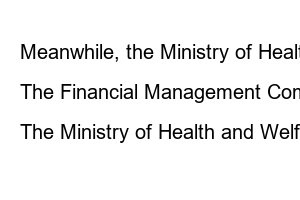건강생활실천 지원금제The Ministry of Health and Welfare held the 12th Health Insurance Policy Deliberation Committee on the 4th.
The Geonjeongshim made a resolution on the revision of the list of drug benefits and the upper limit of benefits, and received reports on the pilot project of the subsidy system for healthy living.
According to the Ministry of Health and Welfare, in order to motivate individuals to self-manage their health, they are promoting a pilot project for a health living practice subsidy system that provides incentives according to healthy living practices and results.
This pilot project is a health investment policy for the preventive field in which the period of healthy living is longer than the period of suffering from disease through personal health management and the protection and management of individual health assets.
The pilot project for the healthy lifestyle subsidy system is scheduled to be implemented from July for voluntary applicants in 24 regions across the country.
Health insurance subscribers with health risk factors or those with chronic diseases participating in the primary care chronic disease management pilot project can apply.
The 24 regions nationwide reflected health indicators, healthy life expectancy, and healthy life practice rates, and were divided into large cities, cities, and counties to ensure even coverage.
Participants’ efforts to practice healthy living and the degree of health improvement will be evaluated, and depending on the results, an incentive of up to 50,000 won to 50,000 won will be provided per participant per year.
The Ministry of Health and Welfare said, “This pilot project is a system that supports people’s self-health behavior and self-management,” and predicted, “It will be possible to confirm the suppression of unnecessary medical use and reduction of medical expenses through preventive management such as chronic diseases.”
Then, he explained, “It is necessary to activate the health care service infrastructure and smart healthcare service,” and “we will continue to provide support for this.”
Geonjeongshim is a treatment for complex skin infections and bacteremia, Kunil Pharmaceutical’s Pentosin Inj. (350, 500mg ingredient name daptomycin), Penmix’s Daptosin Inj. (350, 500mg), Boryung Pharmaceutical’s Boryung Daptomycin Inj. (350, 500mg), Youngjin Pharmaceutical It was decided to apply new insurance benefits for Dapto Inj. (350, 500 mg) of Dapto, Ultomiris Inj. of Handok, a treatment for nocturnal hemoglobinuria, and Pralent Inj. (75, 150 mg) of Sanofi, a treatment for atherosclerotic cardiovascular disease.
In addition, it was also decided to expand insurance coverage for the combination therapy of AbbVie Korea’s chronic lymphocytic leukemia treatment Venclexta (10, 50, 100mg) and Rituximab.
Geonjeongshim decided to apply new insurance benefits from June on whether 6 medicines and 11 items, including pentosine, are eligible for medical care benefits and the upper limit.
For the six drugs, the upper limit and expected billing amount were determined through evaluation by the Pharmaceutical Reimbursement Evaluation Committee of the Health Insurance Review and Assessment Service and negotiations with the National Health Insurance Corporation for clinical usefulness, cost effectiveness, opinions from related societies, and status of listing in excluded countries. .
The upper limit for Pentosin, Daptosin, Boryeong Daptomycin, and Dapto is 40,539 won for 350mg and 49,041 won for 500mg.
Ultomiris injection was decided at 5,598,942 won per bottle.
For chronic lymphocytic leukemia treatment Venclexta Tab. (10, 50, 100mg), which has been covered by health insurance since April 2020, insurance benefits will be expanded from June.
The plan is to expand insurance coverage for combination therapy with rituximab in adult patients with chronic lymphocytic leukemia who have received at least one previous treatment.
The Ministry of Health and Welfare explained, “With this decision, health insurance is applied to new drugs and the scope of insurance coverage is expanded for existing drugs, increasing treatment access and reducing the patient’s burden of medical expenses.”
Meanwhile, the Ministry of Health and Welfare reported the results of the 2022 medical care benefit cost contract to the health care center.
As a result of the negotiations, the Medical Association, Oriental Medicine Association, Pharmaceutical Association, and Investigation Association signed an increase rate of 3.0%, 3.1%, 3.6%, and 4.1%, respectively, but the hospital type and dental type were broken. The National Health Insurance Corporation finally suggested 1.4% for the hospital type and 2.2% for the dental type.
The Financial Management Committee proposed additional resolutions to the Health and Safety Council.
According to the supplementary resolutions, the Health Insurance Review and Assessment Service will maintain fairness with other organizations that have negotiated fees when reviewing and deciding on the cost of medical care benefits for hospitals and dental clinics in 2022. %, dental should not exceed 2.2%.
The Ministry of Health and Welfare plans to discuss the details of the decision on the cost of medical care benefit for hospitals and dentists, where negotiations broke down around mid-June, and plans to decide the cost of medical care benefit for hospitals and dentists in 2022 at a plenary meeting at the end of June.

